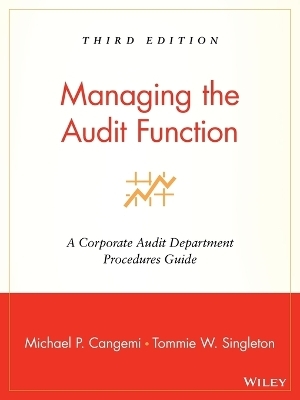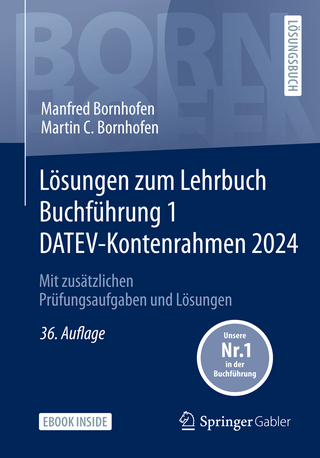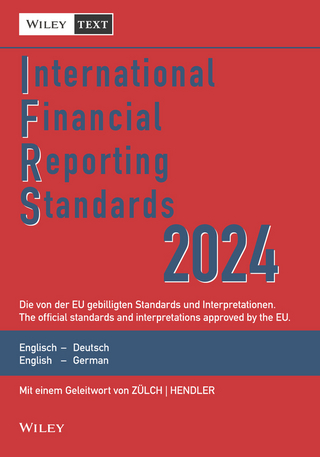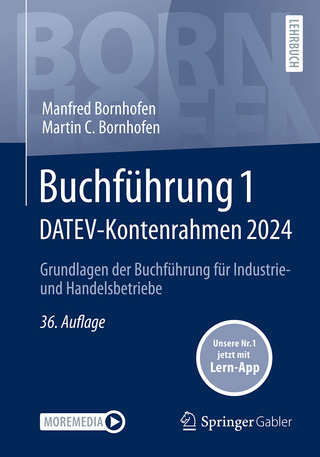
Managing the Audit Function
John Wiley & Sons Inc (Verlag)
978-0-471-28119-1 (ISBN)
Praise for Managing the Audit Function
"The corporate governance issues, accounting irregularities, and legislative actions that have taken place over the past two years have elevated the role and importance of the internal audit function. Managing the Audit Function provides a valuable guide and reference tool for those charged with either executing or overseeing this function."
-- Daniel S. Kaplan, Business Risk Services Partner
Ernst & Young LLP
"It was refreshing to read Internal Audit literature with the appropriate focus on information systems and information systems auditing, since computer systems play such a key role in the processing of accounting transactions and the performance of business operations in today's business environment."
-- William J. Powers, Partner, National Director
Information Systems Assurance Services
BDO Seidman, LLP
"Cangemi and Singleton have created a knowledge management tool for the creation of quality audit manuals and functions. Managing the Audit Function is an important book for all audit managers, and with the addition of new and updated material, including information on the implications and requirements of the Sarbanes-Oxley Act, it provides the information to keep pace with changing conditions affecting the audit function."
-- Robert S. Roussey, Professor of Accounting
Leventhal School of Accounting, University of Southern California
International President, Information Systems Audit and Control Association
" This is basically a procedures manual for an internal auditing department that has been prepared by two of the world's most knowledgeable IT auditors. The book is a handy tool because examples are given throughout of relevant audit documents, such as audit reports, responses to reports, responses to delinquent responses, matrices, checklists, and flowcharts. Every audit department should have this book as a reference manual."
-- Dale L. Flesher, PhD, CPA, CMA, CIA, CFE, CGFM
Professor of Accountancy and Associate Dean
University of Mississippi
MICHAEL P. CANGEMI, CPA, CISA, is President and Chief Executive Officer of Aigner Group, a leading wholesale/retail firm that designs and produces quality branded leather goods. Prior to joining Aigner Group, he was partner and national director of EDP auditing for BDO Seidman, where he founded and directed a service area for internal audit services and was general auditor of Phelps Dodge Corporation. TOMMIE SINGLETON, CPA, CMA, CISA, CITP, is Professor and Director of the Development of Computer Accounting Information Systems and of the Forensic Accounting Program at the University of North Alabama.
Foreword. Preface.
PART ONE: FUNDAMENTALS OF THE INTERNAL AUDITING FUNCTION.
Chapter 1. Background.
1.1 Introduction.
1.2 History of Auditing.
1.3 History of Internal Auditing.
1.4 Auditing Government Agencies.
1.5 History of Information Systems Auditing.
1.6 History of Federal Regulations Related to Auditing.
1.7 Professional Organizations Related to Internal Auditing.
Chapter 2. Auditing Standards and Responsibilities.
2.1 Introduction.
2.2 Ethics.
2.3 Professional Auditing Standards.
2.4 Systems Development Life Cycle Standards.
2.5 Professional Development.
2.6 Responsibilities of a Corporate Auditor.
Chapter 3. Internal Control System.
3.1 Definition.
3.2 Fundamental Assumptions in Establishing an Internal Control System.
3.3 Effective Internal Control Models.
3.4 Regulations.
3.5 Policies.
3.6 Risk Assessment.
3.7 Control Strategies.
3.8 Malicious Activities.
3.9 Specific Controls/CAATTs.
PART TWO: MANAGEMENT AND ADMINISTRATION.
Chapter 4. Department Organization.
4.1 Introduction.
4.2 Corporate Audit Charter.
4.3 Company Organization.
4.4 Audit Department Policies.
Chapter 5. Personnel, Administration, and Recruiting.
5.1 Introduction.
5.2 Personal Development.
5.3 Personnel Files.
5.4 Periodic Performance Evaluation Review.
5.5 Annual Staff Meeting/Conference.
5.6 New Staff Orientation.
PART THREE: TECHNICAL PROCEDURES.
Chapter 6. Audit Planning.
6.1 Corporate Audit Planning, Scheduling, and Staffing.
6.2 Internal Controls.
6.3 Materiality.
6.4 Types of Audits.
6.5 Time Reporting.
6.6 Expense Reporting.
Chapter 7. Audit Performance.
7.1 Corporate Audit Performance Process Matrix.
7.2 Workpapers.
7.3 Audit Objectives.
Chapter 8. Audit Reporting.
8.1 Corporate Audit Report Process.
8.2 Report to Management.
8.3 Report to Audit Committee.
PART FOUR: LONG-TERM EFFECTIVENESS.
Chapter 9. Managing the Effectiveness of the Audit Department.
9.1 Introduction.
9.2 Corporate Governance.
9.3 Quality Assurance.
9.4 Continuous Improvement Systems for Internal Auditors.
9.5 Marketing the Audit Function.
Index.
| Erscheint lt. Verlag | 25.4.2003 |
|---|---|
| Zusatzinfo | Charts: 34 B&W, 0 Color; Tables: 26 B&W, 0 Color |
| Verlagsort | New York |
| Sprache | englisch |
| Maße | 222 x 291 mm |
| Gewicht | 1336 g |
| Einbandart | Paperback |
| Themenwelt | Wirtschaft ► Betriebswirtschaft / Management ► Rechnungswesen / Bilanzen |
| Schlagworte | Revision (Wirtschaft) |
| ISBN-10 | 0-471-28119-0 / 0471281190 |
| ISBN-13 | 978-0-471-28119-1 / 9780471281191 |
| Zustand | Neuware |
| Haben Sie eine Frage zum Produkt? |
aus dem Bereich



